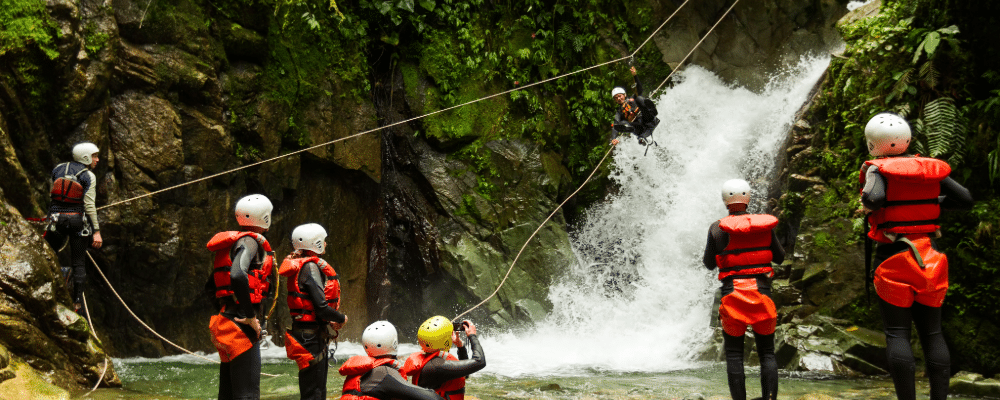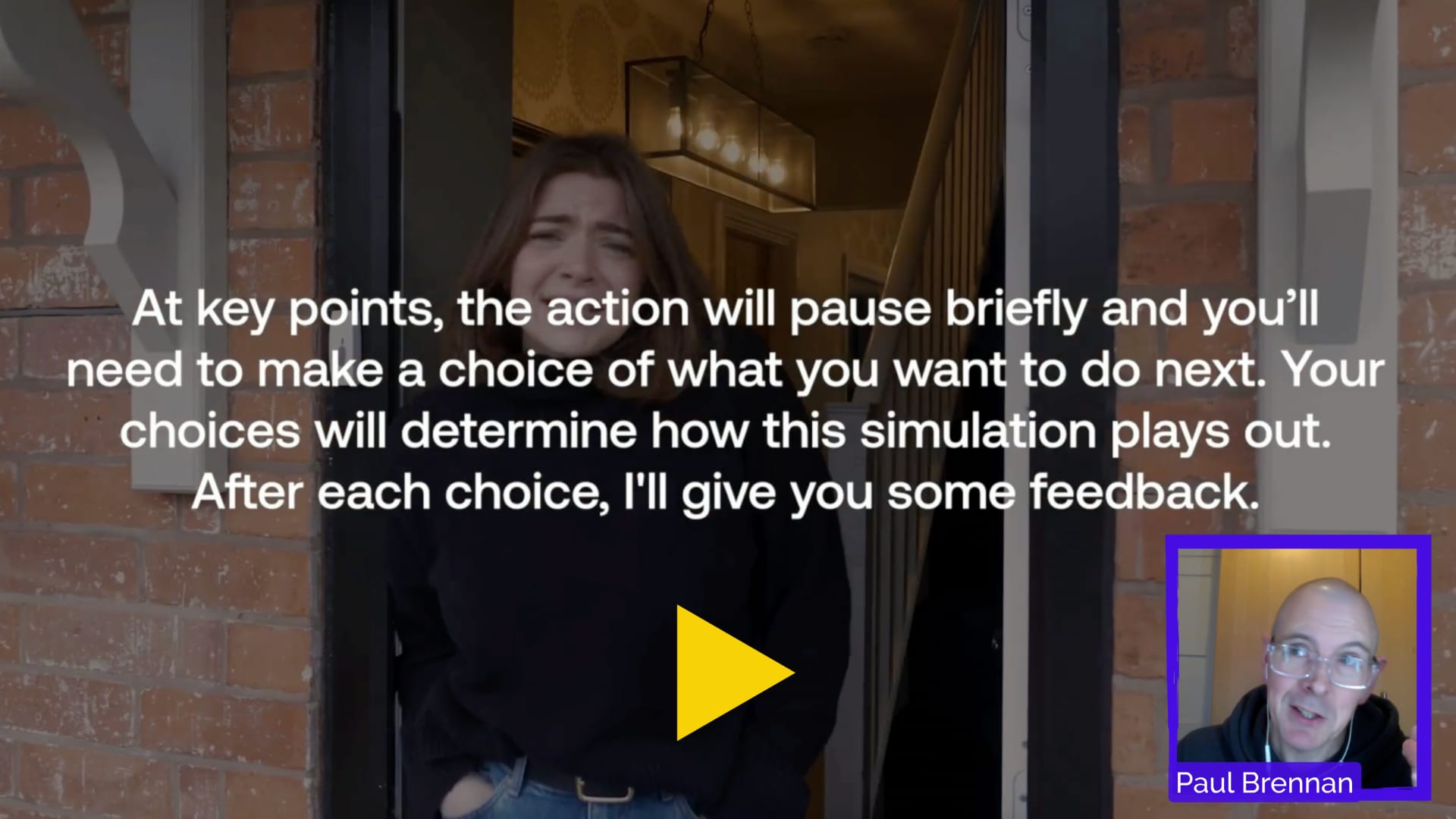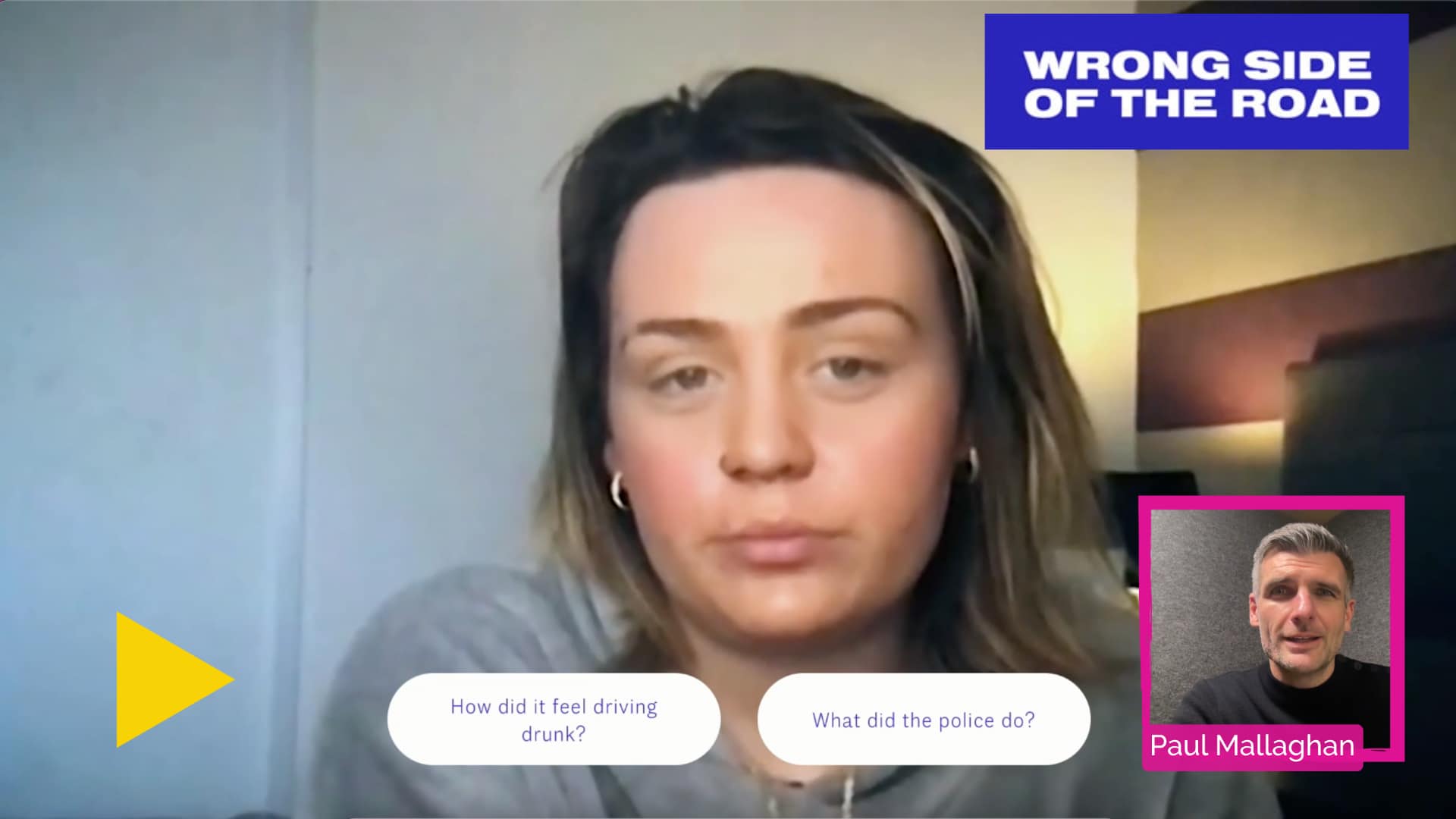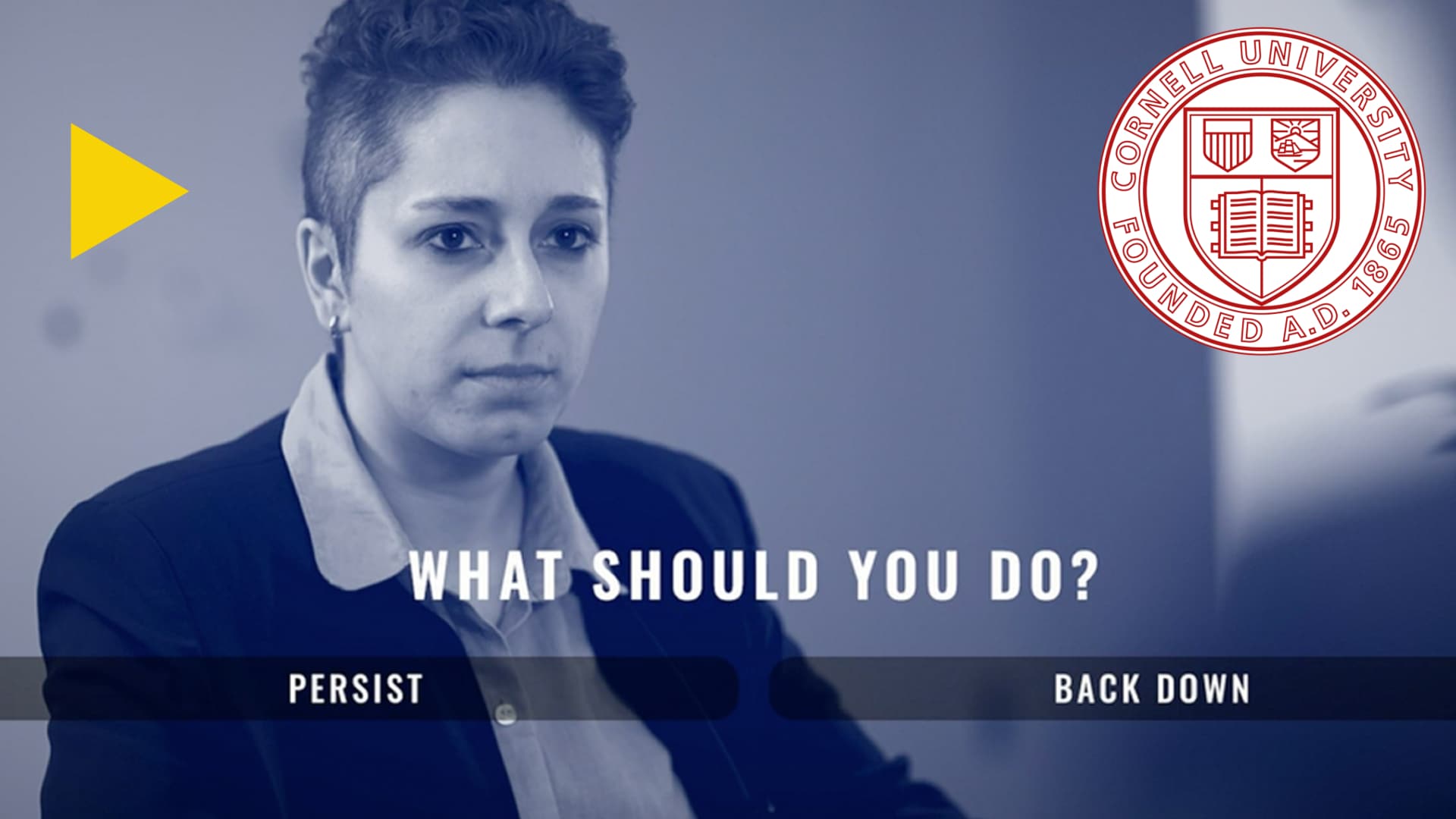Brock Horning | February 2024
Take the cringe factor out of role-play training. Engage your learners in dry, complex topics. Deliver high levels of attitudinal change. It’s time to take adaptive learning to the next level and discover the power of adaptive video.
What is adaptive video?
Take adaptive learning – using technology and data analytics to create personalised learning experiences. Put it together with interactive video – adding clickable elements to let viewers engage with the learning experience directly in real time. And you’ve got adaptive video.
Adaptive video allows viewers to take different pathways through the learning experience – using clickable buttons, links and other interactive elements. By using video rather than static screens, the experience can feel much more engaging. Teachers can guide learners through the subject while maintaining learner agency and personalised journeys.
All the benefits of adaptive learning
Adaptive learning uses technology and data analytics to create personalised learning experiences. Taking the benefits of one-to-one teaching, adaptive learning supports a more thorough understanding, stronger engagement and information retention. Through regular assessments, the learning platform will tweak the difficulty level, content and order in response to the learner’s existing knowledge and competence.
There are clear benefits to this approach:
Individual learning journeys
The platform will respond to the needs of each learner. Assessments identify knowledge gaps and tasks are created to hone in on the learner’s weakest areas. The content and tasks themselves can also be changed to match how the learner best retains information.
Self-paced learning
Learners are given the agency to take on courses and learning concepts at the pace that suits them. Rather than covering skills and knowledge they already know, learners can focus on and repeat specific modules to build competence in new areas. This has proven to encourage engagement and increase time efficiency.
Data analysis and insight
Assessments get to the bottom of what a learner knows – and doesn’t know. The data collected during these assessments and how learners move through the content can inform how the learner retains knowledge and be used to continually improve the experience.
Real-time feedback
Extra help and resource recommendations can be fed back to the learner in real-time. This quick response and direction to additional topics, concept refreshers or remedial lessons helps students obtain mastery over the subject faster.
Effective use of resource
Traditional learning simply can’t deliver personalised learning experiences at scale. Tailored learning journeys that take into account learner’s needs and preferences will always produce better outcomes than generic content. Teachers can satisfy the needs of both at-risk and advanced learners at the same time.
But what if your subject explores the grey areas?
Adaptive learning has clear advantages for subjects like statistics that offer yes or no answers to problems. But what if you’re conducting training in soft skills or ethics where the answers are not quite as definitive and clear-cut? Adaptive learning can help to personalise learning journeys but the teacher needs to be more present to guide the student through the module or subject.
Balance teaching intent with learner agency
Adaptive video for learning addresses this challenge head-on by finding that sweet spot between the teacher’s guidance and the learner’s agency. Interactive, adaptive video is an active learning experience. Teachers can design engaging modules that invite intrigue and curiosity, letting learners discover the answers for themselves.
Within this set-up, the learner maintains that sense of agency. They complete assessments to discover and address knowledge or skills gaps and can replay sections to make sure they fully understand training concepts. Adaptive video passes control to the learner without losing the educator’s guiding hand.
And that’s not all, working in storytelling techniques and real-life scenarios has proven to have a game-changing effect on engagement and information retention.
Key benefits of adaptive media for Learning & Development
Adaptive media has the power to transform your learning and development strategy – and we don’t use the T-word lightly. Here are some of the key benefits:
Role-play real scenarios
As a general rule, humans learn by doing. The best training techniques will put the learner into situations and simulations that are as close as possible to real scenarios. Until recently, this meant awkward physical role-play sessions in training groups. Now, adaptive media can digitally replicate real scenarios allowing viewers to find their way through the experience. The interactive elements let the viewer learn through trial and error in a safe environment. This process means that learners are much more confident and proficient when using these skills in the real world.
Use storytelling techniques to boost emotional engagement
It’s hard to replicate the emotional stakes when designing training scenarios. Take learning first aid, for example. It’s one thing learning CPR in the sterile classroom environment with a manikin, it’s quite another in real life. Adaptive media can use storytelling techniques to recreate the emotive elements of real scenarios. This brings greater engagement in the training scenarios with higher regard for the outcome and consequences. In turn, this results in learners who are ready for the real world with better information recall.
Personalise with a human touch
Automation and algorithms can produce tailored, relevant learning journeys in a way that traditional teaching techniques just can’t replicate. However, we are firm believers that to be truly effective, learning must retain the human touch. Finding that balance between teaching intent and personalised journeys can be challenging with adaptive learning – but not with adaptive video.
Bring in immersive media
Adaptive media is not limited to video. Immersive formats such as virtual reality (VR) and mixed reality (MR) are proving to be highly successful training tools, especially for niche or highly specialised skills. In fact, a PwC study found that learners trained with VR were up to 275% more confident to utilise their newly learned skills – 40% higher than classroom learners. The closer learners get to real scenarios, the better the information recall.
Adaptive video in action
This is all very well in theory but what does it look like in practice? We’ve narrowed down our list of favourite L&D adaptive video examples to just four. These show the range and impact that adaptive video can deliver:
1. Teaching soft skills
Soft skill training is notoriously tricky. Physical role-play just doesn’t create an authentic, engaging atmosphere and there aren’t many other options out there. Learning Designer Paul Brennan was finding that new sales and field engineer employees were going through the induction process but didn’t feel as ready and confident as they should.
Paul used adaptive media to simulate real scenarios for new employees to work through. This took away the discomfort of physical role-play and allowed individuals to work through scenarios time and time again to polish their performance. And Paul was hugely impressed with the results: “Genuinely, it was a game-changer in what we could achieve from a soft-skills perspective.”
2. Engaging in cybersecurity training
How do you get people engaged in topics as dry as cybersecurity training? The team at Living Security set about answering this question using adaptive media and some strong storytelling style. To engage their client’s employees in their annual cybersecurity training, they created an interactive whodunnit film with heavy Knives Out: Glass Onion overtones. Viewers had to question suspects and determine who had leaked the host’s Netflix password.
The aim of the film was to make the training fun, enjoyable and informative – to the point that employees were learning without even realising it. The interactive film was easily repeatable and could used in both group training and one-to-one scenarios. It sparked close engagement and emotional investment through the storytelling techniques and was deemed a wild success by Living Security’s client.
3. Impacting attitudinal change
Beverage giant Diageo tasked creative agency Tilt with creating an educational experience that would challenge the attitudes of millions towards drink-driving. The Tilt team decided that the most influential people would be with individuals who have experienced the dangers of drink-driving first-hand.
Adaptive video was used to set up audience-driven interactive conversations. Viewers could have a virtual ‘chat’ with the interviewee and chose which questions they asked and in what order. By filming these in homes via video call, the stories could speak for themselves in a natural, authentic environment.
Measuring attitude going in to the experience and attitude going out, Tilt achieved a whopping 90% attitudinal change. This meant that viewers understood the dangers of drink-driving better, were more concerned about it and they were more aware of the consequences. The concept was translated across multiple countries, cultures and languages with local stories for powerful impact.
4. Demonstrating data ethics
Cornell University’s Lecturer in Data Ethics lecturer Liz Karns was looking for a way to demonstrate the complexities of data ethics in the workplace. She turned to adaptive video to produce a fictional storyline (based on very real cases) of a workplace decision with huge implications. Viewers could choose to interact at key decision points and discover the ethical ramifications of their choices.
Using storytelling techniques to engage students in this complex topic created an emotional connection. Students were more invested in the topic and became more thoughtful about the outcome which sparked valuable in-class conversations. As Liz said herself: “Students reported to me that they could see the ethical problem and choice consequences more clearly in the island form than typical outlines. From the education standpoint this is a big win.”
Start your adaptive video journey with Stornaway.io
The best way to explore the possibilities of adaptive video is just to jump in and have a go with our free trial. You’ll quickly discover that there are no complex system setups or technical learnings to overcome. Just a simple, intuitive interface that allows you to pick up and play.
As you discover Stornaway’s range of features, look out for the ones that learning teams love:
- Instant playtesting – before you’ve uploaded a single video, Stornaway.io will let you play and test the pathways you’ve mapped out
- Templates – jump into pre-defined template projects that you can customise with your own content.
- Team collaboration – get your whole team working harmoniously together to edit, view and test your project
- White-labelling & domain locking – include your own company branding
- Advanced game-logic – let the viewer keep track of scores, adjust character relationships or manage inventories
- Analytics – see what your audience is watching and engaging with most whilst staying compliant with GDPR, US children’s privacy acts and other privacy regulations around the world
- SCORM/LMS – add conditionals and scoring to your content. Scores can be tracked via our SCORM integration by any LMS platform and tracked on your website. This lets you view learner’s interactions, status and completion rate and track progress in real-time.
- Create VR and Mixed Reality apps – Turn your Stornaway interactive video into an app for Quest, Apple Vision Pro, mobile apps and desktop apps – with no coding!
Adaptive video can take your L&D strategy to the next level
“If the viewer is interacting and entertained throughout the experience, they’re going to withhold the information longer and incorporate it into their daily lives.” – Morgan Obregon, Living Security
Adaptive video can deliver 🌟 ‘spectacular’ results (Learning Designer Paul Brennan’s words, not ours!) By using storytelling techniques to create emotional investment, by balancing teaching intent with personalised journeys, adaptive video can transform your L&D strategy.
Start your adaptive video journey with Stornaway:







